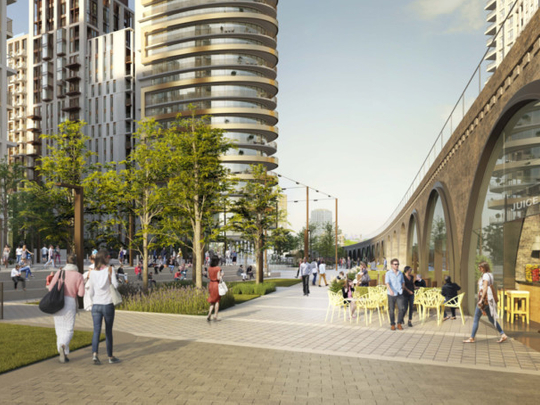
As urban populations grow, people are asking for more from their towns and cities. In London, developers are charged with identifying land that has been underutilised because of former uses or a lack of connectivity, and are challenged to integrate them back into the landscape for community use.
As these emerging places look to establish new identities, how are they to compare to the already well-established and well-loved districts of London? How do they compete? “Placemaking” is their answer. Developers are employing several different approaches to adopt “placemaking” strategies that attract investment and drive footfall in places that people want to call home.
Sarah Curtis, associate partner at Strutt and Parker, comments, “Placemaking is all about creating a good place to live and work, a neighbourhood with a sense of community, with homes which have good access to facilities and shops. Research from Rics has shown that the value of housing can be boosted through good placemaking by around 5 per cent on average. To put things simply, if developers have a clear vision and create well-designed places where amenities are provided as early as possible, people will pay more to live in them.”
Putting place first
Variety can play a role. For Berkeley Group, placemaking begins at inception — choosing locations with potential and working with local people to create places with identity. At its flagship Thames-side development, One Tower Bridge, the developer has introduced a 900-seat theatre to be managed by the London Theatre Company, which will cement its reputation as a new riverside hub on the South Bank. For White City Living by St James, a part of Berkeley Group, homes will be surrounded by bright open space and a boutique retail and leisure complementing the neighbouring Westfield London shopping centre, and add to the well-established districts of Holland Park and Shepherd’s Bush nearby.
Regeneration of brownfield land also provides developers a blank canvas to create a brand-new community. Berkeley Homes’ Southall Waterside is an excellent example. A former gasworks site that is being transformed into a new neighbourhood in west London, Southall Waterside provides 3,750 homes set amid a network of cycle paths and pedestrian routes alongside the historic Grand Union Canal. The development benefits from high-quality infrastructure, thanks to a new Crossrail link, and its new parks and mix of retail and leisure facilities set it up as a prime new destination.
Breathing new life into closed-off corners
In west London, Paddington has long been considered a place that people pass through and not stay. Developers are challenging these perceptions with huge investment, creating new retail and leisure spaces, high-quality offices and attracting top brands. Paddington Gardens by Bahraini developer Meritas Real Estate and Ahli United Bank forms the final piece of the regeneration of the area, and will boast a mix of shops, restaurants, offices, a primary school and a hotel, in addition to 335 new homes, set around an acre of green space.
Curtis notes, “Paddington Gardens is a development which has it all — cutting-edge architecture in an unbeatable zone 1 location, surrounded by an acre of green landscaped gardens. Paddington’s transport connections are unrivalled in the capital. It’s on no less than four of the underground tube lines offering fast access to the rest of London and its railway station is the terminus for the Heathrow Express, a fantastic advantage for frequent flyers. The development is situated right in the heart of one of London’s most exciting residential and commercial regeneration districts, an area which has been historically undervalued in comparison to neighbouring Marylebone and Notting Hill.”
Elsewhere in the capital, Lendlease, best known for its innovation in sustainability, is transforming zone 1 Elephant & Castle by putting green open space centre stage within its placemaking philosophy, creating a new two-acre park at the heart of its flagship urban regeneration scheme, Elephant Park. With an environmental strategy to be carbon positive by 2025 and plant hundreds of new trees, the project showcases the important role green placemaking in creating a sustainable community.
Using retail to create vibrant destinations
Retail landlords are also realising the importance of successful placemaking and brand curation, looking more closely at which retailers work best alongside each other and invigorate an area.
Capital & Counties Properties (Capco) has a well-honed approach to creating a sense of place, having spearheaded the 10-year transformation of the 1-million-sq-ft Covent Garden estate into a thriving retail, dining and residential destination, set within the capital’s theatre district, which attracts over 40 million visitors per year. Placemaking equally sits at the heart of Capco’s second asset, 77-acres in Earls Court, the largest urban regeneration project in west central London. The Earls Court master plan by Sir Terry Farrell will create four urban villages connected by a traditional 21st century high street, with liveable, dynamic spaces, curated retail facilities and vibrant public spaces.
London-based landlord Trophaeum Asset Management has also applied a long-term view to Albemarle Street in Mayfair, bringing in carefully selected luxury brands and transforming the street into a destination for high-end shopping. This strategy is paying off in dividends with the likes of luxury shoe brand Aquazzura and fashion accessories brand Faliero Sarti choosing Albemarle Street for their first standalone UK stores.
Investing in places
In order to create successful new development and retail destinations, developers and landlords alike need to follow this sustained approach to placemaking, which looks beyond the creation of homes or shops to the creation of the most desirable destinations for residents, visitors and businesses. Investing more in public realm, amenities and the right mix of shops and restaurants can create destinations that people enjoy and that will evolve their own unique identities over the years.











